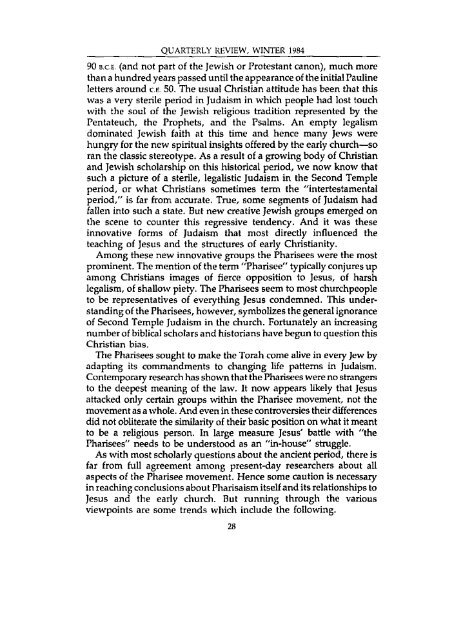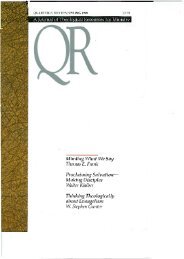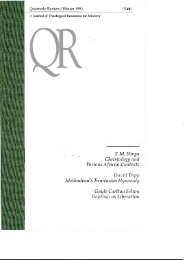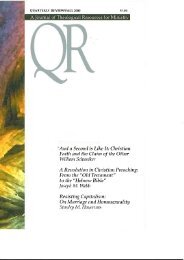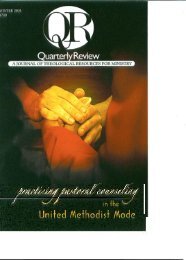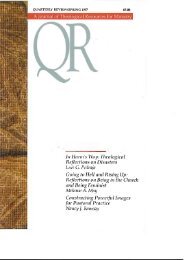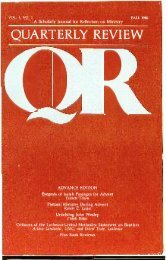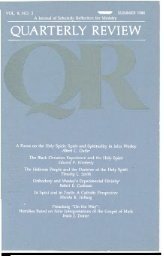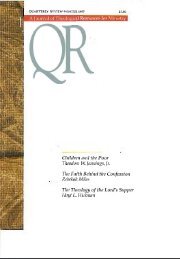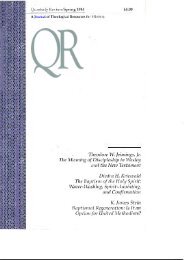Winter 1984 - 1985 - Quarterly Review
Winter 1984 - 1985 - Quarterly Review
Winter 1984 - 1985 - Quarterly Review
Create successful ePaper yourself
Turn your PDF publications into a flip-book with our unique Google optimized e-Paper software.
QUARTERLY REVIEW, WINTER <strong>1984</strong><br />
90 B.c.E. (and not part of the Jewish or Protestant canon), much more<br />
than a hundred years passed until the appearance of the initial Pauline<br />
letters around C.E. 50. The usual Christian attitude has been that this<br />
was a very sterile period in Judaism in which people had lost touch<br />
with the soul of the Jewish religious tradition represented by the<br />
Pentateuch, the Prophets, and the Psalms. An empty legalism<br />
dominated Jewish faith at this time and hence many Jews were<br />
hungry for the new spiritual insights offered by the early church—so<br />
ran the classic stereotype. As a result of a growing body of Christian<br />
and Jewish scholarship on this historical period, we now know that<br />
such a picture of a sterile, legalistic Judaism in the Second Temple<br />
period, or what Christians sometimes term the "intertestamental<br />
period," is far from accurate. True, some segments of Judaism had<br />
fallen into such a state. But new creative Jewish groups emerged on<br />
the scene to counter this regressive tendency. And it was these<br />
innovative forms of Judaism that most directly influenced the<br />
teaching of Jesus and the structures of early Christianity.<br />
Among these new innovative groups the Pharisees were the most<br />
prominent. The mention of the term "Pharisee" typically conjures up<br />
among Christians images of fierce opposition to Jesus, of harsh<br />
legalism, of shallow piety. The Pharisees seem to most churchpeople<br />
to be representatives of everything Jesus condemned. This understanding<br />
of the Pharisees, however, symbolizes the general ignorance<br />
of Second Temple Judaism in the church. Fortunately an increasing<br />
number of biblical scholars and historians have begun to question this<br />
Christian bias.<br />
The Pharisees sought to make the Torah come alive in every Jew by<br />
adapting its commandments to changing life patterns in Judaism.<br />
Contemporary research has shown that the Pharisees were no strangers<br />
to the deepest meaning of the law. It now appears likely that Jesus<br />
attacked only certain groups within the Pharisee movement, not the<br />
movement as a whole. And even in these controversies their differences<br />
did not obliterate the similarity of their basic position on what it meant<br />
to be a religious person. In large measure Jesus' battle with "the<br />
Pharisees" needs to be understood as an "in-house" struggle.<br />
As with most scholarly questions about the ancient period, there is<br />
far from full agreement among present-day researchers about all<br />
aspects of the Pharisee movement. Hence some caution is necessary<br />
in reaching conclusions about Pharisaism itself and its relationships to<br />
Jesus and the early church. But running through the various<br />
viewpoints are some trends which include the following.<br />
28


